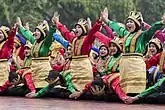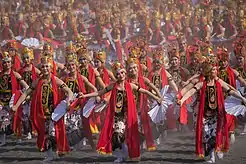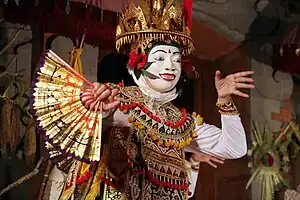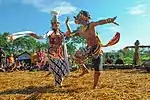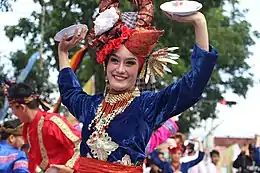| Arja | |
|---|---|
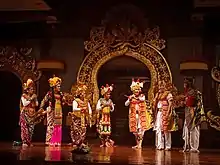 Arja performance in 2020 | |
| Types | Traditional theatre |
| Ancestor arts | Balinese |
| Originating culture | Indonesia |
| Arja (theatre) |
|---|
|
| Burma |
| Cambodia |
| Indonesia |
|
| Laos |
| Malaysia |
| Philippines |
| Thailand |
|
| Vietnam |
Arja (Balinese: ᬅᬃᬚ), also known as Balinese opera, is a popular form of Balinese theatre which combines elements of opera, dance, and drama.[1] It was created in 1825 for the funeral of a Balinese prince. In the beginning it had an all-male cast; since the 20th century all performers (including those playing men) have been women.[2]
The Panji tales are the most important plot material. Since the 20th century, Arja performances have also enacted Balinese mythology and legends as well as Indian (Mahabharata and Ramayana), Chinese, Arabic, and more recently, western and contemporary Indonesian stories.[1][2]
Singing and stylized dance movements are accompanied by gamelan music played with two bamboo zithers called guntang.[1]
See also
References
- 1 2 3 Dibia, I Wayan. "The History of Arja". Balinese Dance. Archived from the original on 18 January 2016. Retrieved 6 May 2020.
- 1 2 Miettinen, Jukka O. "Indonesia: The Twentieth Century". Asian Traditional Theatre & Dance. Retrieved 6 May 2020.
Further reading
- Coast, John . 1953. Dancers of Bali . New York : G.P. Putnam; reissued as Dancing Out of Bali, Periplus Editions, 2004.
- Dibia, I Wayan. 1992. Arja: A Sung Dance Drama of Bali: A Study of Change and Transformation. PhD dissertation, University of California, Los Angeles .
- Dibia, I Wayan and Rucina Ballinger. 2004. Balinese Dance, Drama, and Music. Singapore: Periplus.
- McPhee, Colin. 1966. Music in Bali. New Haven and London: Yale University Press.
- Zoete, Beryl de & Spies, Walter. 1973. Dance and Drama in Bali. Kuala Lumpur: Oxford University Press.
This article is issued from Wikipedia. The text is licensed under Creative Commons - Attribution - Sharealike. Additional terms may apply for the media files.
.svg.png.webp)


